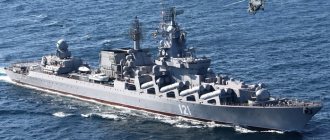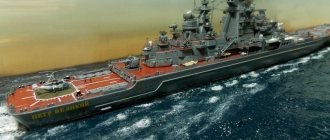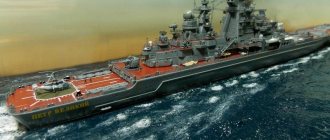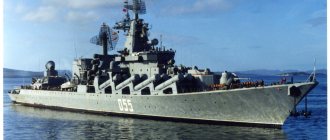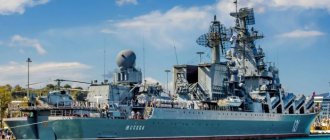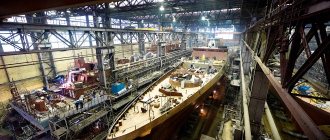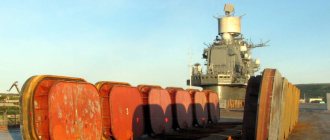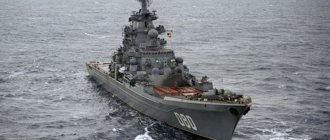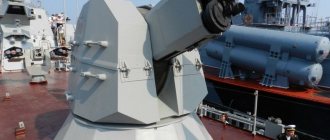In April 1972, the Commission under the Council of Ministers of the USSR decided to develop Project 1164 (code “Atlant”). At first it was planned to build 10 ships of the Atlant series, but in the end 4 were laid down, and only 3 were put into operation, including the most important ship of Project 1164, the cruiser Moskva.
Today, this flagship of the Black Sea Fleet is the only ship of the 1st rank. Let's take a closer look at the history of the creation of the cruiser "Moscow", its technical characteristics and features.
History of creation
As a result of the Vietnam War, the role of naval aviation in modern military conflicts became obvious. Aircraft carriers of the US Navy and NATO were capable of blockading the coast while at the same time striking targets located deep in enemy territory.
Since the Navy of the Soviet Union could not oppose the US aircraft carriers with absolutely nothing, it turned out that the maritime borders of the USSR were not protected and the enemy could reduce all shipping, including inland seas, to zero. This was the main motivation for working on Project 1164.
By the way, at the end of the 40s there was already an attempt to respond to American ships of the Des Moines type, namely Project 66. However, it turned out to be frankly unsuccessful, unlike the missile cruiser Moscow.
It’s not for nothing that the Atlant-class missile ships were nicknamed “aircraft carrier killers” in the West.
In October 1972, the Northern Design Bureau was issued a tactical and technical assignment for the preliminary plan 1164 code Atlant. The director of the Northern Design Bureau, A.K. Perkov, was appointed chief designer for this project, and later he was replaced by V.I. Mutikhin. Captain 2nd Rank A.N. Blinov was appointed as the main observer from the Navy.
On August 21, 1974, the technical part of the project was finally approved.
The laying of the lead ship Slava, later renamed Moscow, took place on October 4, 1976.
The place of missile cruisers in the structure of the modern fleet
In the 70s, it became obvious that the United States was relying on the development of an aircraft carrier fleet. Indicative in many respects was the war in Vietnam, where the main striking force was naval aviation. The aircraft carrier has turned into a convenient and effective military-political tool, capable of locally solving tactical problems. The laying down of a Nimitz-class nuclear-powered aircraft carrier in the United States forced the Soviet military leadership to look for an adequate response to achieve parity at sea. The Soviet Union did not have the technical capabilities to create a powerful aircraft carrier fleet in the shortest possible time. It was decided to create ships with powerful strike weapons capable of operating in the ocean.
The solution to the problem lay on the surface. If in the American Navy the basis of striking power has always been aircraft carriers, then in the Soviet Navy this function will be assigned to missile cruisers. This class of ships was already present in the Navy of the Soviet Union. Suffice it to recall the Kirov-class heavy nuclear cruisers of Project 1144. These huge ships with a nuclear power plant were built as a counterweight to the growing power of the American fleet's aircraft carrier forces. Soviet nuclear-powered missile cruisers were the largest and most powerful warships, around which the main combat core of the fleet was subsequently formed. First of all, this concerns the Northern and Pacific fleets - the flanks on which there is the necessary operational space and a huge coastline. Over time, a ship of this class was supposed to appear in the Black Sea, where it was necessary to restrain the expansion of the Americans in the Mediterranean maritime theater.
The only disadvantage of this project was the high cost of the ships. Building them in large quantities was a heavy burden for Soviet shipyards. It was necessary to find a compromise solution. What was needed was a smaller ship, with a conventional power plant, but in terms of armament power it was not inferior to the domestic TARK of the Kirov type. And most importantly, the cost of the project must be commensurate with the needs of the fleet and the state of the domestic economy.
In the high offices of the Main Naval Staff and in the USSR Ministry of Defense, the concept of a new ship was even developed. It was supposed to be a large warship, classified as a cruiser in terms of displacement and type of onboard weapons. The main purpose of the ship was as follows:
- strengthening the naval group of the Russian fleet with its presence anywhere in the world's oceans;
- combating strike formations of ships of potential enemy fleets;
- deterring the aggressive aspirations of the potential enemy’s fleet on the sea flanks near the sea borders of the USSR;
- carrying out patrol service in areas where large fleet formations are most likely to appear.
The purpose of the ship accurately conveys the motives that guided the Soviet naval leadership when developing the technical specifications on the basis of which Project 1164 was developed and created. The new missile cruisers should become an intermediate link between the heavy nuclear-powered cruisers of the Kirov class, adding their presence to the strike forces of the fleet .
The construction of missile cruisers in the Soviet Union became a “cold shower” for the Americans. The complex of weapons that was installed on the new Soviet ships, the seaworthiness of the ships made them a real threat to the American fleet. It is no coincidence that Soviet Atlant-class missile cruisers received the nickname “aircraft carrier killers” in the West.
Today, the Atlanteans continue to serve in combat as part of the Russian fleet, being considered perhaps the most powerful warships. The missile cruiser Marshal Ustinov is in service in the Northern Fleet. The country's Pacific borders are protected by a ship of the same type - the flagship of the Pacific Fleet, the cruiser Varyag. The guards missile cruiser Moskva is on combat duty at the Black Sea Sea Theater.
Design
On Atlant-class cruisers, the emphasis was placed on gas turbine propulsion systems. Firstly, their cost was lower compared to nuclear fuel engines. And secondly, in this way it was possible to reduce the technical dimensions and displacement.
In addition, the use of light alloys in the design of the missile helicopter carrier allowed it to meet the calculated displacement parameters. The Atlant series missile flagships were to become full-fledged ocean-going ships with powerful missile weapons.
By its design, the anti-submarine cruiser Moscow is a two-masted ship that has a developed three-island superstructure.
Thanks to the inclined stem and frames with a large camber, it was possible to improve the seaworthiness of the vessel.
Most of the hull is made of ship steel, internal bulkheads and partitions are made of durable aluminum alloys. Deck superstructures were constructed in the same way, which were additionally reinforced with steel sheets at the launch sites of combat missiles. The rigging was made from the same aluminum alloys.
And thanks to the double bottom under the fuel tanks, the distribution of ammunition magazines in different parts of the ship and a well-thought-out fire-fighting system, the survivability of Moscow was increased. Even if three adjacent compartments were flooded, the ship could remain afloat without loss of combat effectiveness.
Armament of the “aircraft carrier killer”
The Atlant series ships were created for the new Basalt anti-ship missiles, which have great destructive power. However, later the flagship of the Black Sea Fleet was re-equipped with more powerful Vulcan anti-ship missiles, which made it possible to increase firepower. And along with the reduced mass of the warhead, the firing radius of the missile has increased significantly.
Today the armament of the missile cruiser Moscow consists of:
- anti-ship - Vulcan complex (16 launchers);
- anti-submarine - two five-tube torpedo tubes;
- two rocket launchers RBU - 6000;
- anti-submarine helicopter KA-25/27 with a hangar and helipad;
- two-gun shipborne artillery mount AK-130;
- eight S-300F Fort air defense systems;
- two Osa-MA air defense systems.
Not long ago, a decision was made to modernize the flagship of the Black Sea Fleet, the cruiser Moscow.
It is planned to replace the Vulcan with modern Onyx anti-ship missiles and ultra-precise Calibers. Perhaps the S-300F and Osa-M anti-aircraft systems will be replaced.
TTD:Displacement: 11280 tons. Dimensions: length - 186 m, width - 20.8 m, draft - 6.28 (overall - 8.4) m. Full speed: 32.5 knots. Cruising range: 8070 miles at 18 knots, 2500 miles at 30 knots, 2200 miles at 32.5 knots. Power plant: gas turbine, 2x71000 hp, 2 shafts. Armament: 8x2 launchers of the Vulcan complex (16 P-1000 missiles), 8 B-204 launchers of the Fort anti-aircraft missile system (ammunition load of 64 5V55RM anti-aircraft missiles), 2x2 launchers of the ZIF-122 anti-aircraft missile system “Osa-M” (ammunition capacity of 48 9M33 anti-aircraft missiles), 1×2 130-mm gun mount AK-130 (ammunition capacity 600 rounds), 6 6-barreled 30-mm gun mounts AK-630 (ammunition capacity 48,000 rounds), 2× 5 533-mm torpedo tubes (ammunition capacity of 10 SET-65 torpedoes), 2×12 RBU-6000 rocket launchers (ammunition capacity of 144 RGB-60 jet depth charges), 1 Ka-27PL anti-submarine helicopter (or search and rescue Ka-27PS) . Crew: 485 people.
Ship history:
Missile cruiser pr.1164
In the mid-70s of the 20th century. In the USSR, the Basalt missile system with P-500 anti-ship missiles was created. The missile had a mass of about 6 tons, a firing range of 550 km, a conventional (500 kg) or nuclear warhead, a complex flight path and a speed twice the speed of sound. The P-500 was the first to have an REP system installed, providing protection against air defense systems air strike group. The carriers of cruise missiles, among others, were to be new missile cruisers capable of firing 16 anti-ship missiles in one salvo, which in combat effectiveness was four times greater than the capabilities of the missile cruisers existing at that time.
The development of the project was entrusted to the Northern Design Bureau. The lead missile cruiser of a series of six first in the USSR cruisers with gas turbine units of Project 1164, codenamed Atlant, was laid down on the slipway of the Nikolaev Shipyard named after. 61 communards on November 4, 1976. The ship, named “Slava,” was launched on July 27, 1979, a year later the crew was settled, entered service at the end of 1982, and in February of the following year was included in the Red Banner Black Sea Fleet.
In the history of the Russian fleet, the name “Slava” was borne by several ships. This is a 16-gun frigate that distinguished itself in the war of 1768-1774. with Turkey; at the end of the 18th century. it was replaced by a 38-gun frigate that guarded the waters of the Baltic, and during the 1st World War the battleship Slava fought with the ships of the German fleet.
The ship ended up in the 150th BRN, where until 1990 it represented the main striking force of the Red Banner Black Sea Fleet. In July 1989, a Soviet-American experiment on the possibility of remote detection of sea-based nuclear cruise missiles was conducted on the cruiser Slava. The American group of participants used a device with a semiconductor gamma-ray detector based on a high-purity germanium crystal with an energy resolution of about 2 keV. The detector was placed directly on the launcher of the “aircraft carrier killer” (this nickname was given to Project 1164 cruisers in the West). A spectrum of radiation obtained within 10 minutes with peak values characteristic of various isotopes of uranium, plutonium and some of their decay products confirmed the presence of a nuclear warhead. At the same time, the measurement results showed that in this way it is practically impossible to obtain additional information about the design of the warhead, which suited both sides.
At the beginning of December 1989, the missile cruiser "Slava" took part in ensuring the first meeting of the General Secretary of the Communist Party of the USSR Mikhail Gorbachev with US President George W. Bush on the island. Malta.
In 1990, “Slava” was placed on the stocks of the Nikolaev plant for partial modernization. The planned eight months turned into eight and a half years. There was no funding at all, and for the first five years the cruiser survived only thanks to the dedication of the crew. The patronage of the capital's mayor's office and Yuri Luzhkov personally made it possible to find funds to complete the repairs.
On June 22, 1995, by order of the Commander-in-Chief of the Russian Navy, the cruiser received a new name - “Moscow”
. On June 12, 1997, the St. Andrew's flag was raised on the ship.
On July 19, 1999, after several postponements of release, “Moscow” finally left Nikolaev. In the Ochakov area, the cruiser was received by naval tugs, and three days later, on July 21, the ship notified the evening Sevastopol of its return with volleys of salute guns. On July 25, Russian Navy Day, the flagship of the Russian Black Sea Fleet stood in parade formation in Sevastopol Bay.
In April 2000, for the first time in 10 years, the Moskva went to sea to check the propulsion mechanisms. After checking the weapons, in November the cruiser became part of the permanent readiness forces.
In 2002, the Moskva again entered combat service in the Mediterranean Sea, and in 2003, as part of a formation of Black Sea Fleet ships, it participated in joint exercises with the Pacific Fleet and the Indian Navy in the Indian Ocean.
From 9.08 to 10.09.2008, the cruiser, as part of a group of Black Sea Fleet ships, took part in a peacekeeping operation by Russian troops on the territory of South Ossetia, aimed at forcing the Georgian authorities to peace.
From 02/08 to 02/24/2014, the cruiser performed tasks to support the Winter Olympic Games in Sochi.
GRKR "Moscow" from September 2015 to January 2016 carried out combat service missions in the eastern part of the Mediterranean Sea to provide air defense cover from the sea direction of the air base of the Russian Aerospace Forces in Khmeimim (Syria).
In total, the ship has 19 combat services, including in the Atlantic, Pacific and Indian oceans.
On July 22, 2016, Russian Minister of Defense General of the Army Sergei Shoigu awarded the Order of Nakhimov to the guards missile cruiser "Moscow" in accordance with the Decree of the President of Russia "For services to ensuring the security of the state, high performance in combat training, courage and dedication shown by personnel during performing combat training missions." The ceremony took place in Sevastopol on board the cruiser.
Currently, the ship is part of the 30th division of surface ships of the Russian Black Sea Fleet.
This ship was commanded by: - Rear Admiral Moskalenko, Vadim Olegovich (June 1979 - June 1984); - Captain 1st Rank Viktor Alekseevich Krikunov (June 1984 - February 1988); - Captain 1st Rank Vasilchuk Vasily Vasilyevich (February 1988 - June 1989); - Captain 1st Rank Lesnoy Viktor Sergeevich (June 1989 - June 1993); - captain 1st rank Ermolenko Dmitry Vladimirovich (June 1993 - April 1996); - Rear Admiral Vladimir Ivanovich Bogdashin (April 1996 - February 1998); - Captain 1st Rank Kulikov Valery Vladimirovich (February 1998 - December 1999); - Captain 1st Rank Zheleznyakov Alexey Mikhailovich (December 1999 - 2002); - captain 1st rank Shcherbitsky Alexander Vadimovich (2002 - 2006); - Captain 1st Rank Smolyak Igor Vladimirovich (July 2006 - June 2009); - Captain 1st Rank Sergei Ivanovich Tronev (June 2009 - January 2015); - Captain 1st Rank Schwartz Alexander Tiborovich (January 2015 - December 2016); — captain 1st rank Dobrynin Dmitry Konstantinovich (January 2016 - June 2017); — captain 1st rank Knyazev Oleg Yaroslavovich (July 2022 - May 2020); - Captain 1st Rank Kuprin Anton (May 2022 - to date)
Technical characteristics of Moscow and foreign analogues
To compare the characteristics of our cruiser Moscow and its foreign counterpart, the American Ticonderoga is most suitable, since representatives of this type have similar weapons to our ship. In addition, the design of these ships was carried out almost simultaneously on opposite sides of the ocean.
| Specifications | Russian anti-submarine cruiser Moscow | American Ticonderoga-class cruiser |
| Displacement, tons | 11380 | 9600 |
| Size, m | 186 length, 20.8 width | 172.8 length, 16.8 width |
| Power plant | gas turbine unit: 4 x 22.5 thousand hp. and 2 x 10 thousand hp. | 4 gas turbine units operating on two shafts with a capacity of 80 thousand hp. |
| Travel speed, knots | 34 | 30 |
| Cruising range, miles | 6000 (at 15 knots) and 2500 at 30 knots | 6000 |
| Crew, man | 510 | 360 |
Based on the table, the tactical and technical characteristics of the Russian cruiser Moscow are superior to its American counterpart.
But the US Navy has more than 20 units of this type of ship, while the Russian fleet operates only three Atlant-class vessels.
Builds
From what you need in Moscow:
Perks
1 lvl. There is usually an Art Alert or a Priority Target here. But, in my opinion, both of these perks are useless in Moscow. It’s useless to maneuver from a glimmer of art anxiety - you won’t have time, and the priority taken will always show numbers close to 180, it’s unlikely that this will help you much. Well, we can preventative measures so that the main battery towers live better.
2 lvl. Desperate. You will constantly receive soup, so the perk will work. Considering Moscow's low rate of fire, the perk is very useful.
3 lvl. Superintendent. Don't even think about it. 4 hilks on this Soviet miracle are a strict necessity.
The ones above are really necessary perks that greatly increase Moscow’s combat effectiveness. Everything else has varying degrees of plantaininess.
1 lvl. Change of projectile. It might suddenly come in handy.
2 lvl. Master gunner. Due to the fact that Moscow does NOT play from maneuver, there is no need to quickly rotate the towers and the perk does not provide much profit in battle. But you can take it, sometimes it will come in handy.
3 lvl. Arsonist. Quite often your target will be battleships 20 km away. Since you only have 6 guns, raising the fire chance won't hurt.
4 lvl. Disguise . 16 km of exposure is a little better than 18, but it can be scored. PPP. I came across the opinion that in Moscow you can get fire protection, they say it burns often. It burns, but 2 fires are quite rare. Plus, now cruisers only burn for 30 seconds instead of 60, so the perk loses its relevance even more.
Regarding IW , if reality has undergone a strong cataclysm and 12 American battleships are always fighting - Montana, Iowa, and other Carolines - the perk is required to be installed. Before such a cataclysm occurs, kill it.
Why aren't air defense perks mentioned? Because they are useless. There are almost no Aviks in battles at high levels. And if you pulled out a “lucky ticket”, then nothing will save you from an Avik except a barrier - have you seen an Avik long ago that misses a battleship? And if the barrier is pressed, the Avik simply won’t climb on you, next time it will drown you.
Have you noticed that the perks of the entire line of Soviet cruisers are not very suitable for Moscow? Somewhere around here a greedy Jew is running by and quietly whispering “just fuck it up...”, but you can also take advantage of elite experience. If you have one, of course.
Modernization
1 slot. Vitality of main battery. No alternatives.
2 slot. Accuracy , the increase is preventive, but at least some. Air defense range. If you see Aviks at every step.
3 slot. Main battery range. Don't even think about taking rammers or any other crap. Strictly main battery range.
4 slot. SBZZH , or whatever you prefer. Upgrading to a radar is even better if you have one.
5 slot. Steering wheels - no alternative.
6 slot. Disguise. The chance to at least sometimes get lost from the enemy's sight is a very useful thing. But you can also install rudders. In terms of usefulness, they are about equally useless.
Consumables
Strap. Gold is good, but you can leave the regular one.
GAP. Are you planning to play in KB? You can also pendurate the gold one, but the regular one is usually enough. Barrier. Nowadays it is rarely used more than once per battle. The usual one is enough for the eyes.
Radar. For the most part, you will use it about 1-2 times in battle, a regular one will be enough for this. But there are cases of acute confrontation with destroyers and then the gold one can “decide”.
Khilka. Goldovaya, strictly.
History of the service of the flagship of the Black Sea Fleet
The ship was launched in 1982, and a year later it was put into operation. He repeatedly served in the Mediterranean Sea and visited the ports of various states.
- 1986 - arrived in the Greek port of Piraeus;
- 1989 - ensured the security of USSR President Gorbachev during a meeting with the American president, which took place on the island of Malta;
- 1991 - the cruiser Moscow returned to the Nikolaev plant for repairs, where the ship remained for more than 8 years. Due to political instability, the fate of the missile cruiser was unclear; there was even talk of decommissioning the ship due to the lack of funds for its modernization. However, already in 1998 the ship received a flag and a guards rank, and in 1999 it arrived at the port of Sevastopol;
- 2003 - he took part in the Russian-Indian naval exercises Indra -2003;
- 2004 - joint exercises with the Italian Navy;
- 2008 - Moscow, together with the aircraft-carrying cruiser Admiral of the Fleet of the Soviet Union Kuznetsov, was on combat duty in the Mediterranean. The guards missile ship demonstrated its combat power in August of the same year, during the armed conflict with Georgia;
- 2012 - the ship ceased to be a separate military unit;
- 2013 - the ship was on a long voyage, visiting a number of countries (Portugal, Nicaragua, Cuba, Venezuela);
- March 2014 - the flagship, together with other ships of the Black Sea Fleet, blocked the Ukrainian Navy in Donuzlav Bay. And already on September 17, the missile cruiser replaced the SKR Smetlivy in the Mediterranean Sea, where it carried out combat service;
- The end of January 2015 - the flagship of the Black Sea Fleet returned from a campaign in Sevastopol.
Missile cruiser "Moskva" - video
During his service in September 1986, the RKR visited the port of Tartus (Syria) on a business visit, and from November 18 to 22, 1986, the port of Piraeus (Greece) made a friendly visit. In April 1987, he went to sea under the flag of the Navy Civil Code of Admiral S.G. Gorshkova. In August 1990, the cruiser participated in the Yalta International Conference on the identification and control of nuclear weapons on board warships. From March 21, 1991 to August 1998, Shipyard named after. 61 Communards "Moscow" underwent a medium repair. At the same time, all the AK-630M guns were removed from him, which were transferred to the Shipyard as payment for the work performed. Then the ship was towed to the Sevmorzavod shipyard in Sevastopol, where repairs were completed and the AK-630M AU, taken from the fleet’s arsenal, was reinstalled. In 2001, the ship paid a friendly visit to the port of Tunisia. At RKR Moscow and Marshal Ustinov, during the mid-term repair of the Basalt anti-ship missile system, it was upgraded to the P-700 anti-ship missile system of the Vulcan complex. However, these anti-ship missiles cannot use standard launch stages, since their operation can lead to the destruction of the launcher. As a result, they are equipped with P-500 anti-ship missile launchers, which somewhat reduces the flight range.
Interesting facts about Moscow
- Initially, the missile cruiser was named by the legendary traditional name Slava, and was renamed Moscow only in 1996;
- In 2016, the guards ship Moscow was recognized as the best ship of the Black Sea Fleet;
- The ships of the Atlant series and in particular the cruiser Moscow are not essentially aircraft carriers, since they do not have aircraft on board. Rather, Moscow is a helicopter carrier;
- Officially, patronage of the flagship of the Black Sea Fleet is assigned to the capital;
- In 1989, an experiment was conducted on the cruiser in collaboration with the American military, the purpose of which was to establish the possibility of remote detection of nuclear cruise missiles. The flagship partially coped with the task;
- The Atlant series ships are the first ships using the ship-helicopter system. Before this, such a system had not been used on Soviet ships;
- It takes a ton of paint to paint the outer hull of a boat;
- The ship has a ZIF-121 installation, which allows it to interfere with an attempt to detect it;
- To combat enemy torpedoes and submarines, the ship is equipped with two Smerch-2 bomb launchers;
- To destroy the lead ship of the 1164 series, it is necessary to fire at least 6 Vulcan-type missiles, while only one or two will be able to reach the target;
- With one engine, the Cruiser Moscow is capable of traveling at a speed of 13...14 knots;
- In 2016, the flagship was awarded the highest award - the Order of Nakhimov;
- After a Russian fighter was shot down over Syrian territory by the Turkish Air Force in November 2015, the Russian government decided to deploy the anti-missile cruiser Moscow off the coast of Syria.
TTX
Artillery Main Corps
220 mm guns - I’ll be honest and straight away - are some of the best cruising guns in the game. 5.8 rounds per minute, 19.5 km range in stock, and railgun ballistics. At the same time, there are no complaints about the shells - the land mines are only slightly weaker than those of Zao and Henri, and the bb are as fierce as those of the Hindenburg, famous for its armor-piercing guns. Use shells depending on the situation; Moscow is quite versatile in this regard. Landmines do a good job of damaging both light destroyers and heavy armored vehicles, and bombshells made from selected Soviet Stalinium will readily take out a citadel from any imperialist scum. At the same time, for land mines you don’t need an inertia at all; they already penetrate most targets without any perks.
But there can’t be a barrel of such delicious, Soviet honey, clearly made by bees according to GOST, without a small fly in the ointment nearby.
Ballistics are the best you've ever seen on a cruiser, starting at a kilometer/second, at maximum distance (with upgrades) the projectile flies for 12 seconds. So what's the downside? The fact is that due to the specifics of combat in Moscow, you do not have the feeling that you are shooting from lasers. It’s as if you are shooting from an ordinary cruiser, but not at the usual 18 km, but at 22. And if the target you are firing at is fast enough (Khabarovsk, Henri), then sometimes you have to take a very, very significant lead. Personally, having read a lot about Moscow railguns, I expected a little more.
DPM. 9 guns is not what you expect from a tier 10 cruiser. Yes, there is an example of Des Moines and Henri, who live quite well with these 9 guns, but Des Moines has a crazy rate of fire, and no one is interested in Henri at all (from the moment of his introduction, 3.5 people pumped him in and immediately abandoned him). Moscow’s problem is that it only has 9 guns according to its passport, but in battle, most often, there are 6 of them. This means forget about the spectacular volleys that tear off a wild bunch of HP from the adversary, most often you will be forced to “saw” the enemy. But more on that later.
Torpedoes
No and no need. How so, why not? The fact is that even if they were, you would not have the opportunity to use them.
Air defense
The distant aura is very powerful, 111 units. damage per second, and even 5.7 km of base range. Average aura, 3.5 km, and 124 units of damage, we won’t even remember about the close one, it’s a measly 50. And for a level 10 cruiser, this, to be honest, is not enough. Yes, you can lavish air defense on Moscow, make the distant aura like a huge umbrella, but what’s the point? Moscow still won’t become Hindenburg or Des Moines; it won’t be able to fend off Avik even in a full air defense build, and now Aviks still need to be looked for at levels 10.
Vitality
65400 HP. The largest number of combat units per level among cruisers. It would seem that with an average of 30% more HP than its competitors, Moscow should be an imbo? Not at all.
The quantitative metric of combat effectiveness is indeed approximately equal to the number of Uzbeks in one square meter of Moscow, but these Uzbeks are taken out only on the road. Let's start with the fact that Moscow has no armor. The citadel is covered with a 155 mm armor belt, but behind this armor belt there are no tricky bevels, additional armor plates, nothing. Just a huge citadel sticking high out of the water. There is no need to shoot at the waterline for Moscow - shoot somewhere on board, and you will be happy. And the traverses of the citadel cannot be called thick, if you naively think about tanking with your nose, any owner of a 406 mm fool will quickly destroy your dreams.
Everything would be fine, because Des Moines is protected in approximately the same way. There's just one thing. Des Moines is not the size of Yamato!
You know, among American comedians there are popular jokes about comparing mothers’ asses with various objects and other things indicating enormous size. For example, “your mom has such a huge butt that it takes 21 days to walk past it in the supermarket.” Fortunately, none of these comedians have ever heard of the Project 66 cruisers, because there’s simply nothing to cover the “your mother’s ass is as huge as the cruiser Moscow” card. There are practically no objects anymore in the observable universe!
Moscow is not just huge, it is gigantic, the current capital of Russia, along with its entire region, such dimensions simply could not be dreamed of. Can you guess how this affects the survivability of a ship that has cruising armor?
Naturally, all enemies on your map know about this wonderful phenomenon. Therefore, Moscow is being focused FOCUS. Everything that can shoot on your flank shoots at it. She is often shot at from other flanks. Well, when Moscow begins its truly royal turnaround maneuver, the whole card is thrown away for health. At times it seemed to me that the shells were also coming from outside the map, from neighbors hacking away there.
Maneuverability
760 meters circulation radius, 10.9 seconds rudder shifts “in stock”. A person who has never played Moscow may think that this is the best tenth cruiser in the game in terms of maneuverability.
In practice, the size of the ship plays its part, so Moscow’s maneuvers, although they begin quite abruptly, continue for a very long time. Decided to “quickly” turn around in front of three enemies? Choose a cozy place at the bottom. Are you thinking of quickly dodging a fan of torpedoes suddenly sneaking up on board? Don't worry and just choose your next ship.
Any attempts to play “out of maneuver”, as normal representatives of the cruiser class do, in Moscow end with literally 3-4 enemy salvoes and departure to the port. So get used to the fact that under your command is something closer to battleships than cruisers.
Moscow, just like the political course of the Kremlin standing on it, is fast in words, but everything is done very slowly and strictly in one direction.
Disguise
In the clear ocean sea, without any shooting, many battleships “overexpose” Moscow. Well, what else can I add?
Do you think that by confining yourself to a disguise, the situation will get better? Not really. The maximum result that can be achieved is something like 14 km. Believe me, for most of the battle the enemy destroyers will be closer to you, so you won’t be able to catch yourself and go into invisibility.
Influence on political processes and prospects
In 2022, the flagship of the Black Sea Fleet should leave the port of Sevastopol and arrive north. Here at the ship repair facility its modernization and repair will be carried out. Previously, Moscow’s twin “Marshal Ustinov” was repaired at the plant, during which most of the electronic systems and radio engineering complex were updated.
The further fate of the cruiser Moscow is not yet clear, as there is information in the media that after repair work, Moscow may remain part of the Northern or Pacific Fleet. It is worth noting that in 2016, the flagship took part in the Syrian operation, where it showed its best side.
Today, one of the important tasks of Russian geopolitics is to gain and strengthen influence in the Mediterranean, which is an important tactical springboard.
Of course, the anti-missile cruiser Moscow has disadvantages, namely the presence of only one multi-channel radar for illuminating targets of the S-300F air defense complex. And after it is disabled, the ship is left without adequate protection.
In the future, after the Black Sea Atlant is modernized and its weapons and technical characteristics are improved, the cruiser, if not superior to its foreign counterparts, will certainly not be inferior. As a result, this will help Russia increase its influence in the Mediterranean, displacing the US fleet. .
Project evaluation
In total, 4 cruisers were laid down under Project 1164, of which 3 vessels were completed and entered service - one of each of them is serving in the Northern, Black Sea and Pacific fleets of Russia. In general, we can admit that the Project 1164 missile cruisers were a fairly successful alternative to the overly expensive Project 1144 Orlan heavy missile cruisers. Having a limited displacement, Project 1164 missile cruisers had virtually equivalent offensive weapons and comparable defensive weapons.
Moreover, priority in their creation was given not to defensive, but to offensive weapons. The ships have a reduced supply of missiles for the S-300F air defense system - 64 versus 96 on the Orlans, and the weak point is the self-defense air defense, which consists of only 2 outdated Osa-M air defense systems. Project 1144 cruisers have 16 Kinzhal launchers. In general, the ships of Project 1164 corresponded to the “late” doctrine of the Soviet fleet - the use of attack surface missile carriers under the cover of carrier-based aircraft.
The cruiser's biggest drawbacks include the presence of only one multi-channel target illumination radar for the S-300F air defense system (Volna radar). In addition to leaving the ship without adequate protection if it malfunctions, it also prevents the cruiser from repelling an attack from more than one direction at a time.
For comparison, comparable-sized American Ticonderoga-class cruisers have 4 independent target illumination radars, which allows them to repel simultaneous attacks from more than one direction. The presence of only one guidance radar significantly reduces the ability of Project 1164 ships to combat modern anti-ship missiles with multi-sector attack capabilities.
